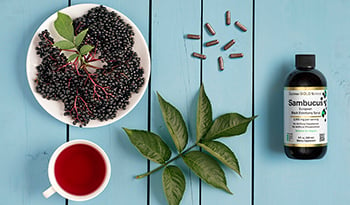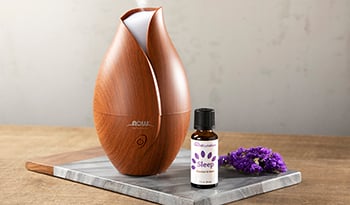13 Natural Treatments for the Common Cold and Flu

The common cold, a type of upper respiratory infection (URI), is the most frequent infection a person will encounter in their lifetime. It is estimated that there are more than 220 different cold viruses which infect humans. After exposure, it normally takes one to three days for illness to start, and the duration of a cold is usually seven days, but in some cases can last several weeks. The same virus never infects the same person twice, and while there is no cure for the common cold, there are ways to prevent infection.
More dangerous than a cold is the Influenza virus, also known as The Flu. The Flu affects millions of people worldwide annually. Sometimes the flu can result in death in high-risk individuals (i.e. diabetics, those with lung disease, senior citizens and cancer patients). Death is usually the result of a secondary bacterial infection such as pneumonia, which can occur due to one’s immune system having been weakened.
Prevent Illness from Starting
Prevention is truly the best medicine, and this is especially true when it comes to the common cold and flu. There are ways to help keep your body strong so you can try to resist infection:
Diet – Consume a healthy diet, rich in fruits and vegetables that vary in color. This provides antioxidants, which protect the body and prepare the immune system against viruses and bacteria.
Hand washing – Frequent handwashing with antibacterial soap and warm to hot water is the most effective way to prevent the spread of a viral illness. In addition, avoiding rubbing your eyes and nose is crucial. A quality hand sanitizer should also be kept nearby.
Avoid sick contacts – If possible, avoid being in the presence of sick people. If you are, ensure there is adequate fresh air in order to dilute the number of germs in the air to which you are being exposed.
Cough into elbow – When ill, cough into your sleeve or elbow instead of coughing and sneezing into your hand. Remind others who are ill in your presence to do the same.
Get Sleep – Adequate sleep is required to keep the immune system strong. A 2016 study in the Journal of the American Medical Association (JAMA) showed sleeping fewer than 6 hours a night increases the risk of contracting a cold.
Conventional Treatment
Antihistamines
Antihistamines can help minimize symptoms of a cold, at least during the first few days. A 2014 review by the Cochrane Review database concluded, “Antihistamines have a limited short-term (days one and two of treatment) beneficial effect on severity of overall symptoms but not…long-term” Despite this, physicians frequently recommend antihistamines such as:
- Diphenhydramine (Benadryl) – a common over the counter antihistamine medication, commonly causes drowsiness
- Loratadine (Claritin), fexofenadine (Allegra) or cetirizine (Zyrtec) – a non-drowsy antihistamine medication.
Cough Syrups
- Dextromethorphan (Delsym, Robitussin, etc.)
- Promethazine cough syrup
- Sometimes, when prescribed by a physician, codeine, a weak narcotic is added to the syrup. This can be dangerous for some, especially children.
Pain medications
Prescribed for aches and pains, common symptoms during a severe cold.
- Acetaminophen (Tylenol, Paracetamol) – helpful for many when taken for a short time, if taken for prolonged periods of time, can put extra stress on the liver and lower the antioxidant glutathione.
- NSAIDs (Non-Steroidal Anti-inflammatory Drugs) - Ibuprofen (Motrin, Advil), Naproxen (Aleve, Naprosyn) and Celecoxib (Celebrex) are helpful when used for a few days. However, if taken long term, these medications increase the risk for kidney disease, heart attacks and strokes, according to the Federal Drug Administration (FDA), who oversees drug safety in the United States.
Antiviral FLU medications
- Zanamivir (Relenza) or oseltamivir (Tamiflu) reduces flu symptoms by one day when taken within 48 hours of illness onset, when compared with placebo. Tamiflu can cost up to US $150.
Influenza Vaccination
- Influenza vaccination may be most helpful for those with chronic diseases such as diabetes and lung disease. The Centers for Disease Control (CDC) in the United States recommends the flu vaccine for everyone 6 months and older. Ask your doctor if the flu vaccine is right for you.
Natural Treatments
There are many natural vitamins and herbs that have been studied over the years to help reduce symptoms of a cold and symptoms of influenza.
Zinc Lozenges – Zinc is a mineral. Numerous studies show zinc’s benefits for preventing the common cold. A 2016 study in the British Journal of Clinical Pharmacology concluded “common cold patients may be encouraged to try zinc lozenges for treating their colds” while a 2017 study concluded “common cold patients may be instructed to try zinc acetate lozenges within 24 hours of onset of symptoms.”
Starting zinc lozenges as soon as you are exposed to a virus is advised. This important mineral supplement should be kept in one’s medicine cabinet, so it can be started as soon as symptoms are felt. Another 2017 study showed both zinc gluconate lozenges and zinc acetate lozenges are equally effective. Suggested dose: Zinc Lozenges 30 mg as directed on the label.
Vitamin C – Vitamin C, also known as ascorbic acid, has been recommended to help prevent the common cold for decades, but humans have a genetic mutation that makes us unable to produce ascorbic acid, unlike other species. A 2014 study showed that vitamin C could reduce risk for developing a cold and also reduced the duration of the cold when compared to placebo (sugar pills). Other studies showed those under “physical stress”, we're more likely to benefit from vitamin C and cold prevention. More studies however are needed. Suggested Dose: 500 mg to 2,000 mg daily.
Vitamin D – Low levels of vitamin D, most common during the winter, have been shown to be associated with increased risk for contracting a cold or influenza infection. Optimizing vitamin D intake and sunlight exposure may be a good way to help prevent infection. Suggested dose: Vitamin D 2,000 to 5,000 IU daily.
Probiotics – Probiotics have been shown to be effective in the prevention of upper respiratory infections and appear to be an up-and-coming treatment for chronic sinus disease. A 2015 study by Cochrane Review showed those taking probiotics were less likely to develop an upper respiratory infection, less likely to need antibiotics, and less likely to miss school when compared to those subjects not taking probiotics.
Further, a 2016 study in a popular allergy journal concluded that nasally introduced probiotics could help chronic sinus problems. There are a lot of studies demonstrating the importance of a healthy gut microbiome and its role in overall health. Evidence from a 2017 study suggested that “an unhealthy gut increases the risk for sinus problems and inflammation in the sinus passage”. Suggested dose: 5 billion to 60 billion units of probiotics daily is advised.
Lactoferrin – Lactoferrin is a protein which has both antibacterial and antifungal properties, according to studies. This protein is usually found in the tissue of the sinus passages and may be helpful for those with frequent upper respiratory infections. Suggested dose: 300 mg daily.
Honey – A cough is a common symptom of an upper respiratory infection. The effectiveness of cough syrup and the safety concerns in children has concerned many. The use of honey has become a popular cough treatment recommended for children by Family Physicians and Pediatricians alike. A 2017 study showed that honey improves daytime and nighttime coughs in children with a cold.
In 2016, Dr. Grogan stated in the Journal of The American Academy of Family Physicians, “For patients one to 18 years of age, providing honey for cough symptoms can reduce the frequency and severity of a cough, as well as improve sleep for patients and parents, when compared with placebo or no treatment”.
Herbal Supplements
Herbal supplements have played an important role in treating symptoms of a cold in both Traditional Chinese Medicine (TCM) and Ayurvedic medicine. Listed below are those that have been shown effective against viral respiratory infections.
Astragalus Membranaceus – Used for over 2,000 years, this adaptogenic herb is an immune stimulant and believed to help prevent upper respiratory infections. In TCM, it is frequently used with other herbs. A 2013 study of children with chronic kidney disease showed this herb reduced the likelihood of contracting a cold. More studies are needed. Suggested dose: Astragalus 500 to 1,000 mg daily.
Elderberry – (Sambucus nigra L.) Historically used by many indigenous cultures for upper respiratory infections. A 2016 study concluded that elderberry showed a significant reduction of cold duration and cold severity in air travelers who took the herb. Studies also show elderberry has activity against the influenza virus. Suggested dose: Elderberry 600-900 mg/day,
Echinacea – Echinacea has been used for almost 2,000 years. A 2016 study published in Holistic Nurse Practitioner demonstrated Echinacea could help prevent the common cold. Other studies have shown similar findings. Frequently consumed as Echinacea tea or in supplement form. Suggested dose: Echinacea 400 mg once or twice per day
Garlic – We all know garlic can keep vampires and a future spouse away, but can it keep a cold virus away? The active ingredient in garlic is allium sativum. A 2001 study which evaluated 146 people. Half were given a garlic supplement, the other half a sugar pill (placebo). After the 12 week study, the author concluded “Consequently, volunteers in the active group were less likely to get a cold and recovered faster if infected. Volunteers taking placebo were much more likely to get more than one cold over the treatment period. An allicin-containing supplement (garlic) can prevent attack by the common cold virus”.
A more recent review in 2014 where multiple studies were evaluated, concluded there is insufficient evidence of garlic’s effectiveness and that more studies are needed. No negative side effects were noted. Suggested dose: Garlic 100 mg daily.
Andrographis – An herbal supplement native to India and commonly used in Asia. A 2004 study concluded that this herb “may be an efficacious treatment for the symptoms of a URI”. Also, a 2010 double-blind, placebo-controlled study showed andrographis performed significantly better in reducing symptoms of an upper respiratory infection when compared to a placebo. Suggested dose: Andrographis 300- 400 mg up to 3 times per day.
Herbal Tea - There is nothing more soothing than a warm cup of tea to help minimize symptoms of a respiratory infection. These teas include peppermint tea, ginger tea, Echinacea tea and more. Learn more about therapeutic teas.
Essential Oil – Rosemary, peppermint and eucalyptus essential oils are recommended to help alleviate the symptoms of a cold, according to a 2011 study. They can also help with influenza symptoms. They can be used with a diffuser or rubbed directly into one’s chest.
Summary
Infections with a pathogenic virus can cause things from the common cold to deadly influenza. To date, there is no cure for these infections. However, there are measures which can be taken to prevent infection, reduce symptoms and strengthen the immune system. Some of these medications are pharmaceutically developed while others are herbal supplements that have been used for thousands of years in Traditional Chinese Medicine, Ayurvedic medicine, Holistic Health Practitioners and now people, all over the world. Those seeking more natural ways to care for an illness are rediscovering the wisdom of our ancestors. No matter what route you take, if your respiratory symptoms do not improve over a few days, seek the service of a qualified healthcare professional to make sure a more serious infection is not present. Live righteously and be well!
References:
- Prather AA, Leung CW. Association of Insufficient Sleep With Respiratory Infection Among Adults in the United States. JAMA internal medicine. 2016;176(6):850-852. doi:10.1001/jamainternmed.2016.0787.
- Cochrane Database Syst Rev. 2015 Nov 29;(11):CD009345. doi: 10.1002/14651858.CD009345.pub2.
- Hemilä, H., Petrus, E. J., Fitzgerald, J. T., and Prasad, A. (2016) Zinc acetate lozenges for treating the common cold: an individual patient data meta-analysis. Br J Clin Pharmacol, 82: 1393–1398. doi: 10.1111/bcp.13057.
- Hemilä H, Fitzgerald JT, Petrus EJ, Prasad A. Zinc Acetate Lozenges May Improve the Recovery Rate of Common Cold Patients: An Individual Patient Data Meta-Analysis. Open Forum Infectious Diseases. 2017;4(2):ofx059. doi:10.1093/ofid/ofx059.
- Johnston CS, Barkyoumb GM, Schumacher SS. Vitamin C Supplementation Slightly Improves Physical Activity Levels and Reduces Cold Incidence in Men with Marginal Vitamin C Status: A Randomized Controlled Trial. Nutrients. 2014;6(7):2572-2583. doi:10.3390/nu6072572.
- Hao Q, Dong B, Wu T. Probiotics for preventing acute upper respiratory tract infections. Cochrane Database of Systematic Reviews 2015, Issue 2. Art. No.: CD006895. DOI: 10.1002/14651858.CD006895.pub3
- Am J Rhinol Allergy. 2016 Nov 1;30(6):202-205. doi: 10.2500/ajra.2016.30.4372
- Vickery TW, Ramakrishnan VR. Bacterial Pathogens and the Microbiome Otolaryngol Clin North Am. 2017 Feb;50(1):29-47. doi: 10.1016/j.otc.2016.08.004.
- Psaltis, A. J., Wormald, P.-J., Ha, K. R. and Tan, L. W. (2008), Reduced Levels of Lactoferrin in Biofilm-Associated Chronic Rhinosinusitis. The Laryngoscope, 118: 895–901. doi:10.1097/MLG.0b013e31816381d4
- Am Fam Physician. 2016 Jul 1;94(1):20-1. Honey for Acute Cough in Children. Grogan SP, Egitto EA.
- Z ou C, Su G, Wu Y, Lu F, Mao W, Liu X. Astragalus in the Prevention of Upper Respiratory Tract Infection in Children with Nephrotic Syndrome: Evidence-Based Clinical Practice. Evidence-based Complementary and Alternative Medicine : eCAM. 2013;2013:352130. doi:10.1155/2013/352130.
- Krawitz C, Mraheil MA, Stein M, et al. Inhibitory activity of a standardized elderberry liquid extract against clinically-relevant human respiratory bacterial pathogens and influenza A and B viruses. BMC Complementary and Alternative Medicine. 2011;11:16. doi:10.1186/1472-6882-11-16.
- Ross SM. Echinacea purpurea: A Proprietary Extract of Echinacea purpurea Is Shown to be Safe and Effective in the Prevention of the Common Cold. Holist Nurs Pract. 2016 Jan-Feb;30(1):54-7. doi: 10.1097/HNP.0000000000000130.
- Lissiman E, Bhasale AL, Cohen M. Garlic for the common cold. Cochrane Database of Systematic Reviews2014, Issue 11. Art. No.: CD006206. DOI: 10.1002/14651858.CD006206.pub4.
- Schwalfenberg G. Vitamin D for influenza. Canadian Family Physician. 2015;61(6):507.
- Joanna Thompson Coon, Edzard Ernst Andrographis paniculata in the Treatment of Upper Respiratory Tract Infections: A Systematic Review of Safety and Efficacy Planta Med 2004; 70(4): 293-298 ]
- Saxena RC, Singh R, Kumar P, et. Al A randomized double blind placebo controlled clinical evaluation of extract of Andrographis paniculata (KalmCold) in patients with uncomplicated upper respiratory tract infection.
- Phytomedicine. 2010 Mar;17(3-4):178-85. doi: 10.1016/j.phymed.2009.12.001. Epub 2010 Jan 25.
- Ben-Arye E, Dudai N, Eini A, Torem M, Schiff E, Rakover Y. Treatment of Upper Respiratory Tract Infections in Primary Care: A Randomized Study Using Aromatic Herbs. Evidence-based Complementary and Alternative Medicine : eCAM. 2011;2011:690346. doi:10.1155/2011/690346.
DISCLAIMER:This Wellness Hub does not intend to provide diagnosis...














































































 Table of Contents
Table of Contents















